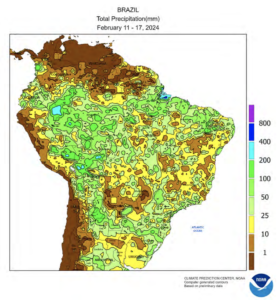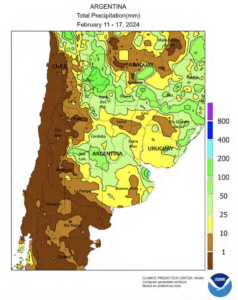China will suspend retaliatory tariffs on U.S. imports, including duties on farm goods, after last week's meeting of the two countries' leaders, Beijing confirmed on Wednesday, but imports of U.S…
Brazil, Argentina Crop Production Estimates Cut
Soybean production estimates for Argentina and Brazil, along with corn production estimates for Argentina, were lowered earlier this week by agribusiness consultancy Agroconsult and the Rosario Grains Exchange.
“Brazil’s 2023/2024 soybean crop estimate has been reduced to 152.2 million metric tons from the previous estimate of 153.8 million tons, agribusiness consultancy Agroconsult said on Tuesday, citing adverse crop weather in key producing states,” according to reporting from Reuters’ Ana Mano and Roberto Samora.
“Argentina’s Rosario grains exchange cut its estimates for the country’s 2023/24 soybean and corn harvests on Wednesday to 49.5 million and 57 million metric tons, respectively, due to a heat wave in late January and early this month,” Reuters’ Maximilian Heath reported. “The exchange has previously calculated the soybean harvest at 52 million tons and the corn harvest at 59 million tons.”
Brazil
“In Mato Grosso, Brazil’s biggest farm state, Agroconsult experts evaluated crops in the north, west, middle-north and southeast regions,” Mano and Samora wrote. “The areas planted in the state between the beginning of September and mid-October, which correspond to around 40% of the total, were the most affected by high temperatures and low rainfall, Agroconsult said.”
The Mato Grosso average yield estimate was pegged at 52.5 bags per hectare, according to Mano and Samora, which is 17.7% below last year’s harvest.
“Another state hurt by dry weather in December and January was Mato Grosso do Sul, Agroconsult said referring to fields in the south of that state,” Reuters’ reported. “After visiting farms there, Agroconsult lowered average yield forecast for Mato Grosso do Sul to 57.5 bags per hectare from 59 bags in the previous projection.”
So far, Agroconsult has covered about 60% of the farmland areas it will survey, which is about 30,000 kilometers.

The United States Department of Agriculture reported earlier this week that, in Rio Grande do Sul, “corn was nearly 60% harvested; meanwhile, nearly 75% of soybeans had flowered but none had reached maturity.”
In Mato Grosso, “soybeans were 65% harvested as of February 16, 5 points ahead of last year’s pace; corn planting was 65% completed, compared with 50% last year and the 5-year average of 58%,” the USDA said.
Argentina
“A period of higher-than-usual temperatures that began on Jan. 17 left the corn crops (in Argentina) with less-than-ideal water levels, the exchange said, despite rains that offered some relief the second week of February,” Heath reported. “Argentina’s corn crop is however projected to hit a record level this season, even after the heat wave’s impact.”
“Argentina’s critical soybean crop was also impacted by the ‘very long and severe heat wave’ that hit farmlands ‘at a very sensitive time for early soybeans,'” Heath wrote.

Heath reported that the exchange stressed the need for both the corn and soybean crops to receive rain in the coming days and weeks to “to secure the crop’s recovery and sustain the season’s potential.”





